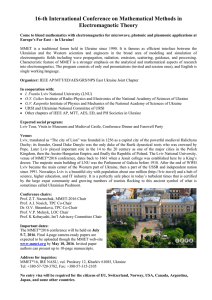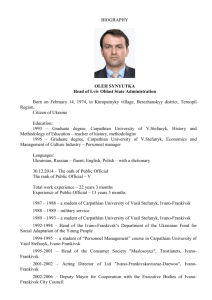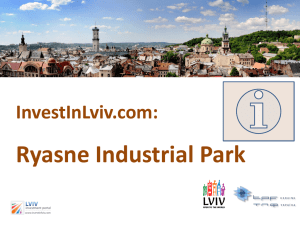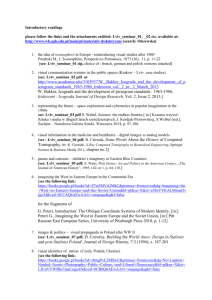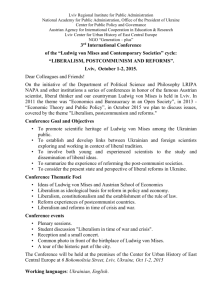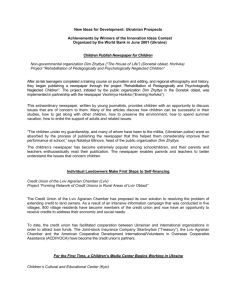SWOT ANALSYSIS OF THE LVIV OBLAST This SWOT analysis is
advertisement
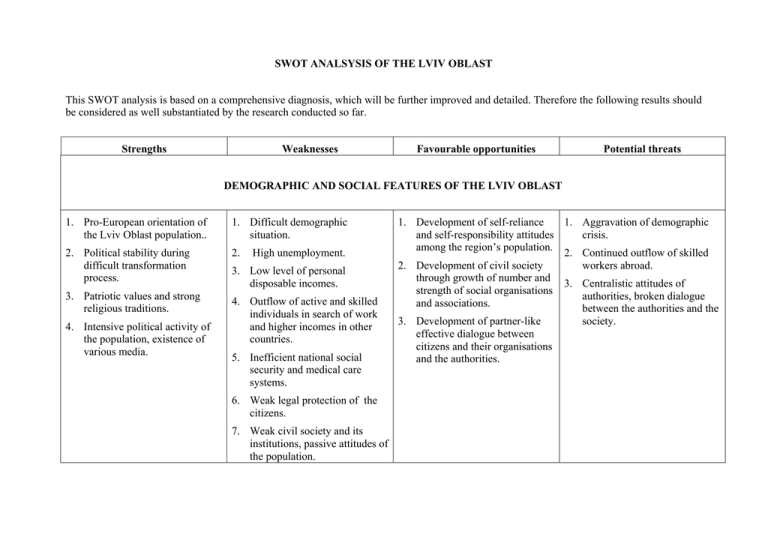
SWOT ANALSYSIS OF THE LVIV OBLAST This SWOT analysis is based on a comprehensive diagnosis, which will be further improved and detailed. Therefore the following results should be considered as well substantiated by the research conducted so far. Strengths Weaknesses Favourable opportunities Potential threats DEMOGRAPHIC AND SOCIAL FEATURES OF THE LVIV OBLAST 1. Pro-European orientation of the Lviv Oblast population.. 1. Difficult demographic situation. 2. Political stability during difficult transformation process. 2. 3. Patriotic values and strong religious traditions. 4. Outflow of active and skilled individuals in search of work and higher incomes in other countries. 4. Intensive political activity of the population, existence of various media. High unemployment. 3. Low level of personal disposable incomes. 5. Inefficient national social security and medical care systems. 6. Weak legal protection of the citizens. 7. Weak civil society and its institutions, passive attitudes of the population. 1. Aggravation of demographic 1. Development of self-reliance crisis. and self-responsibility attitudes among the region’s population. 2. Continued outflow of skilled workers abroad. 2. Development of civil society through growth of number and 3. Centralistic attitudes of strength of social organisations authorities, broken dialogue and associations. between the authorities and the 3. Development of partner-like effective dialogue between citizens and their organisations and the authorities. society. INTERNATIONAL AND DOMESTIC POSITION OF THE LVIV OBLAST 1. Traditional cooperation with Poland and favourable transborder relations. 1. Near-the-border location, close to new member states of the European Union; 1. Peripheral location in Europe. 2. Historical links with Austria and Poland 3. Relatively bad international image of Ukraine. 3. Location on planned and existing transcontinental main transport corridors (road and rail) linking Western Europe with Asia. 3. Improvement of image of 4. Not fully utilised opportunities Ukraine in Europe. of international co-operation of 4. Development of international the Oblast, its cities and co-operation (economic, rayons. cultural, tourist) of Ukraine. 5. Weak Euroregions which do not utilise all opportunities for 5. Efficient use of EU-financed programmes for institutional international co-operation and strengthening and promotion. infrastructure development. 4. Emerging metropolitan status of Lviv as the scientific, economic and tourist centre of the western Ukraine 5. Cheap and relatively well qualified labour, attractive for foreign investment. 6. Large incomes transferred from working abroad 2. Insufficient transport and border-crossing infrastructure. 2. Development of transport and border infrastructure. 6. Emergence of new economic opportunities through closer ties with the EU countries and consolidation of the European integration. 7. Efficient co-operation with other regions of Western Ukraine. 1. Insulated border after EU enlargement and decrease of “petty trade” leading to growth of unemployment. 2. Slow process of reforms, marginalisation of Ukraine in Europe. 3. Peripheralisaiton of Western Ukraine within the socio-economic Ukrainian space. 4. Outflow of more active and better qualified people abroad. 5. Losing competition of the Ukrainian firms on the integrated EU market. 6. Negative economic outcomes of ecological measures forced by the EU. 7. Deterioration of foreign exchange (mostly with Poland) due to expansion of the EU. 1. 2. 3. 4. 5. 6. ECONOMIC DEVELOPMENT, BUSINESS AND ENTREPRENEURIAL POTENTIAL 1. Ukraine becoming the member 1. Unstable economic situation of 1. High unemployment. High diversification of Ukraine. of WTO enterprises 2. Underdevelopment of small 2. Unstable political situation in and medium-sized enterprises. 2. Fast expansion of high-tech Some industrial branches Ukraine. industries utilising local relatively modern and well3. Not sufficiently advanced innovation potential and developed (e.g. mechanical 3. Lack of growth of international process of privatisation, too labour. engineering, agricultural contacts of Ukraine, weakening its great importance of the statemachines, instrument-making) political and economic contacts 3. Rapid development of SMEs. owned large companies. with the EU. Relatively well developed 4. Fast and rationale 4. Unfavourable economic telecommunications system 4. Lack of structural changes, shallow privatisation. structure and its slow changes, decentralisation, persisting worn down fixed assets, High capacity transport 5. Enlargement of businessdominance of state administration obsolete technologies. communications, cross section supporting attitude of regional over elected bodies. of railways, motor routes and and local administration. 5. Unfavourable structure of pipelines 5. Unwillingness of regional elites to incomes and its changes. 6. Inflow of innovative foreign undertake modern paradigm of Public participation in NGOs capital. 6. Poor competitiveness of development. activities production, unfavourable 7. World Bank and the EBRD export structure. Availability of raw materials 6. ----------------------------------loans for infrastructure (coal, oil, potassium, sulphur 7. Persisting corruption. projects 7. Unfavourable business etc). environment (unstable taxes, 8. Too strong competition from 8. Development of business improper tax management, national and foreign economic supporting and financial difficult credit, poor business centres, EU (high-tech), Poland infrastructure. support infrastructure). (food processing). 9. Inflow of EU funds 8. Underdevelopment of high9. Growth of grey economy. (Neighbourhood Instrument). productivity sector in 10. Petrification of “low segment” in 10. Decrease of unemployment. agriculture. foreign investment 9. Inefficient administration, long 11. Low absorption capacity of EU bureaucratic procedures, funds corruption. 10. Shortage of well trained managers. 11. Poor living conditions for highly-skilled professionals TECHNOLOGY AND INNOVATION POTENTIAL 1. Relatively high educational and professional level of the population (mainly in the city of Lviv). 2. Several professional training and educational institutions. 3. Existence of several advanced scientific establishments well connected with world science. 4. Existence of several technologically advanced companies, operating in fastgrowing sectors. 5. Availability of schools, libraries and institutions of higher education 6. Developed institutional system of personnel training. 7. Availability of well trained personnel. 1. Internal and external braindrain form science. 2. Difficult financial situation of academic and research institutions. 3. Poor technical equipment of academic and R&D institutions, difficult access to scientific literature. 4. Poor international scientific contacts, specially in humanities. 5. Underdevelopment of training, re-training and skillrefreshment agencies. 6. Weak contacts between business and R&D sectors. 7. Inexistence of a Regional Innovation System and institutions of technology transfer. 1. Support of regional government rendered to the best scientific teams and institutions. 2. Development of international contacts of academic and R&D institutions. 1. Stagnation of the academic and R&D sector of Ukraine. 2. Continuing domestic and international brain drain from science. 3. Continuing marginalisation of Ukrainian science in international scientific networks. 3. Support of the European Union for academic and R&D sectors 4. Underdevelopment of congress in Ukraine and competitive facilities in the city of Lviv position of Lviv in these programmes. CULTURAL AND TOURIST POTENTIAL 1. Historic old city of Lviv enlisted in the UNESCO World Heritage register 2. Outstanding theatres and museums. 3. Availability of natural and recreational recourses, like healing mineral waters, natural and landscape parks, monuments of landscape art etc. 4. Numerous sanatoria and health resorts. 5. Potential for sentimental, religious and other kinds of tourism. 6. Historic relations with Ukrainian diaspora in the world. 1. Insufficient number of hotels of various standards. 2. Attractiveness of the Lviv Old Town jeopardised by social pathologies and urban decay. 3. Insufficient tourist promotion of the region. 4. Underdevelopment of local and national travel agencies 5. Absence of the Lviv region in international travel and tourist networks. 6. Insufficiently developed infrastructure of environmental protection. 7. Ecological problems (dumps of Lviv, Novy Rozdil, Yavoriv and Stebnyk). 8. Insufficient funding for cultural, educational and art facilities and organisations. 1. Development of “sentimental” tourism for Ukrainians, Poles, Jews etc. 1. Decay of architectural monuments and the city urban structure 2. 2. Efficient international promotion of Ukraine and Lviv region. 3. 3. Improvement of the country’s and region’s international 4. image. 4. Improvement of the ecological situation of the region, preservation of its mostly valuable natural environment. 5. Improvement of various facilities of tourist and recreational base. Lack of active and efficient promotion of the region on international scale. Persistence of bad international image of Ukraine and Lviv region. Lack of improvement of the tourist infrastructure targeted to different segments of demand. 5. Difficult ecological situation, including threat to safe living due to intense operation of transport corridors. 6. Reduction of investment for ecology and environment protection. LVIV OBLAST 2015: A VISION OF HOPE AND CHANCE By 2015 Lviv Oblast will at least double its regional GDP, which will be made possible by sustaining a high and stable rate of growth of its regional economy, equal to not less than 6.5 per cent yearly. This, in turn, will allow for a marked improvement of the level of living of its population, eradication of the utmost urban and rural poverty and for increasing the quantity and quality of social and municipal services for oblast inhabitants. However, due to initial lower levels of both per inhabitant and personal incomes, the Lviv Oblast will be still three to four times behind the average region of the European Union and two times behind Central European countries. This will also be reflected in the level of incomes of the population which may grow no more than slightly over two times. This very fact will allow the Lviv Oblast to enjoy a stable and growing level of inflow of foreign capital, mainly from the European Union countries, which by the year 2015 will invest in the region not less than 2 billion USD. Due to lower labour costs, the foreign capital will locate itself in labour-intensive sectors of economy, which will require, however, well qualified and disciplined labour force, provided by efficient regional universities, colleges and training establishments. Stable regulations, friendly attitude of national, regional and local administration and its specialised services will create a favourable business climate within the region, which will be competitive on an international scale. Successful restructuring of the obsolete industrial complexes will free public resources from the necessity of subsidising inefficient companies, and will allow for investing these funds in undertakings which will increase living conditions of the population, as well as the attractiveness of the region for investors and tourists. Improved business environment will well serve local businesses, too. Lviv Oblast will become a concentration of entrepreneurial spirit and dense network of interrelations and contacts between the business agents, business-supporting organisations and R&D establishments. This will lead to an increase of competitiveness of the regional economy on the international and domestic markets. This will be possible due to its potential for creative adaptation of innovations and efficiency, as well as a well and carefully utilised locational potential as an intermediatory region between the EU economies and the growing markets of Ukraine and Russia. Wide and effective participation in the EU-financed programmes, directed towards its immediate neighbours, will be one of decisive factors of this leading role of the Lviv Oblast in the fruitful (not only economic) cooperation between East and West in wide array of issues. Lviv Oblast will become a leading Ukrainian region in terms of skills and practice of designing, implementing and monitoring the EU programmes, and will be sharing this knowledge with other Ukrainian regions on their way to integration with the European Union. The Lviv Oblast will maintain its natural and cultural diversity, which will become the main asset for tourist development. As a result of Lviv and oblast cities historical and architectural environment preservation, cultural tradition recreation and development, full utilization of region’s recreational potential and targeted image building, it will increase its attractiveness to domestic and foreign tourists. Oblast cities and rayons will be able to offer them well developed tourist base and friendly attitude of the local population, who – through providing tourist services – will increase its incomes. The parts of the Oblast which will not be able to demonstrate sufficient entrepreneurial spirit and potential for growth will receive assistance from oblast and local administrations through the implementation of educational programs as well as measures facilitating entrepreneurship development. The overall developments of the region will make it attractive for the citizens of the Oblast. They will enjoy the growing incomes obtained not only from work but also the increased social assistance. The region will offer them opportunities for personal carrier advancement, and individual efforts will be remunerated by high professional positions and decent incomes. The region will be an attractive place for living and for making business. THE GENERAL, STRATEGIC AND OPERATIONAL GOALS FOR THE LVIV OBLAST 2015 The Mission of the Lviv Oblast Strategy - the General Goal The strategic goals are subordinated to Lviv Oblast Strategy mission, which should be considered as an ultimate, general goal of the socio-economic development of the Oblast and the main guideline of all activities and actions of the public authorities of the oblast, its rayons and municipalities. The mission is formulated as follows: Achievement of the strategic goals will lead to an increase of well-being of the present and future population of the Lvivska Oblast. In particular, the inhabitants of the region will have rich opportunities of fruitful realization of their professional, educational and cultural aspirations, will enjoy social security and efficient healthcare, and will be living in clear and friendly natural environment. To achieve this goal the authorities create favourable conditions for human personal development and individual entrepreneurship, which helps the Lvivska Oblast to become an attractive place for living, personal advancement and competitive economic activity. This ultimate goal of the strategy – the well-being of present and future population living in the Lviv Oblast – recognizes the fundamental importance of economic development, which is a necessary precondition for the growth of personal incomes of the employees, of the social benefits delivered to those who are not economically active and the of and quality of services provided by the public authorities to the inhabitants of cities, towns and villages of the Oblast. “In order to distribute one has to create” – this principle is reflected in strategic and operational goals in this document. The strategic goals are directed to activity, creativity and entrepreneurship of the citizens of the Oblast. It is recognized that the people themselves are responsible for their well-being and personal advancement, providing that the public authorities on all levels and tiers: national, regional and local, create conditions which open favourable opportunities for personal development. Thus the main orientation of the strategy itself and its goals is to create these opportunities for the citizens, the organisations and firms and companies of the region so that they would be able pursue their own interests, aims and goals (providing they are not harmful for the more general ones) in order to create incomes, jobs and foundations for future development of the region. The financial capabilities of the regional authorities are and will be limited. Therefore the undertaking for which the regional authorities take responsibility should be directed more toward organisation, inspiration and leadership, and less related to massive capital outlays, which go beyond the financial resources of the regional budget. Below four strategic goals for the Lviv Oblast are formulated. These goals do not follow sectoral or branch structures, but are constructed according to functional dimensions of regional development. Some examples of operational goals are also displayed – their list is not complete and closed. Operational goals herein reflect the ways for the achievement of strategic goals. It is expected that the implementation of strategic goals will result in the following improvements of the social problems and quality of life of the citizens: • decrease of unemployment and increase of population employment rate; • increase of population incomes and its purchasing power, which will result in an increase of consumption and living conditions; • increase of revenues of the local budgets and their ability of funding the regional and local social programmes; • improvement of conditions for individual advancement which will encourage people to live and work in the region instead of emigrate abroad; • alleviating social tension within the society and improving the social confidence towards the regional and local authorities. The relation between the General Goal of the strategy and the strategic goals are presented in the following diagram: 4.4. Development of recreational potential infrastructure. traditions 4.3. Preserving the historical heritage. Developing tourist 4.2. Strengthening cultural potential and multiethnic 4.1. Enhancing attractiveness of landscape, improving quality of natural environment General Goal of the Strategy: Increase of well-being of present and future population of the Lvivska Oblast, through: • creating rich opportunities for fruitful reali-zation of professional, educational and cultural aspirations; • providing social security, efficient healthcare, good housing and municipal infrastructure; • securing clean and friendly natural environ-ment. 3.1. Adaptation of educational system 3.2. Enhancing the scientific potential. 3.3. Increasing innovative potential 3.4. Strengthening links between business and research. Strategic goal 3: Lviv Oblast – the region of educated people, innovative potential and technologically advanced companies Strategic goal 2. Lviv Oblast – the gateway of Ukraine to the European Union 1.1. Favourable conditions for existing companies. 1.2. Favourable conditions for new firm creation and investment. 1.3. Development of infrastructure. 1.4. Increasing human capital and social capital 2.1. Enhancing openness and international contacts 2.2. Enhancing cross-border cooperation with Polish partners 2.3. Lviv Oblast – the leader in international programmes Strategic Goal 4: Lviv Oblast – the region of clean and attractive natural environment, culture, tourism and recreation Strategic Goal 1: Lviv Oblast – the region of stable and entrepreneurial development The mission and the following strategic goals of the Lviv region are deeply rooted in the National Strategy for Ukraine adopted in 2004. In particular, if has to be mentioned that this national strategy identifies the well being of the Ukrainian population as the main and ultimate objective of the economic development and all activities of the public authorities. This is fully reflected in the Mission of the Lviv Strategy. It should be recalled that the National Strategy formulates the following four main priorities of the national development of Ukraine: • stable and high rate of growth of the national economy which would allow to cover the development gap existing at present between Ukraine and the EU member states; • advancement towards the European Union and achieving a status of an associated country and later a full membership in the EU; • increase of the innovative potential of the country, its academic and research establishments, which would secure – through intensified co-operation between science and business – an increase of the technological level of the Ukrainian companies and therefore growth of their international competitiveness; • such a reorientation of the national social policy which would allow for achieving a faster economic growth through development of a strong middle class with its pro-business and pro-efficiency attitudes and values. As it can be seen below, the Lviv Oblast strategy fully follows these principles, adapting them to the features and specific potentials and opportunities of this particular region. This Lviv region, through full and efficient utilisation of its human and natural resources and its geographical location, is being enabled to fulfil the assumptions of the national socioeconomic development, thus considerably adding to the prosperity of the country and its people. THE GOALS Strategic Goal 1: Lviv Oblast – the region of stable and entrepreneurial development The transformation process of Ukraine has not led to creating sound foundations for stable and fast growth of the national economy. Lviv Oblast has not been exceptional in this process. However, improving living conditions and allowing for greater integration with the global economy necessitates fast and stable positive growth which would be based on modern and competitive economic, social and institutional structures. Therefore creating conditions for high growth rate is a prerequisite for development of sectors and branches of the regional economy and for improving quality of life of the population. Economic development in market economy results from a combination of several factors, among which the existence of entrepreneurial initiative among population, skills and qualifications and freedom in decision making by independent business units are of special importance. Creating favourable conditions for private initiative and entrepreneurship becomes one of the most important preconditions of economic growth in the region and the creation of up-to-date economic structures. The regional authorities – in collaboration with local government - have a wide array of instruments which may be used in creating conditions for fast growth and enhancement of entrepreneurship. The operational goals of the strategy will indicate possible ways and means of intervention. Operational goal 1.1. Creating favourable conditions for development and modernisation of the existing economic structure of the region Potentials: the already achieved economic development, the relatively diversified economic and professional structure and the entrepreneurial activity of the population have resulted in emergence of relatively modern economic structure of the Lviv Oblast, which predestines it to become one of the national concentrations of stable and fast economic growth. Drawbacks: Throughout the first period of transformation the level of economic development has decreased in the whole of Ukraine, and only recently the national economy has demonstrated an ability for growth. The persistence of the current recovery is still to be confirmed, since it does not fully stem from the structural change. Lviv Oblast economy is overshadowed by the state enterprises and the modern private sector – especially market services and modern industry - is relatively underdeveloped, which is due to underutilisation of the entrepreneurial potential which seems to await incentives and assistance. Actions: 1.1.1. Development of business-support infrastructure for small and medium-sized enterprises through supporting already existing and creating new agencies and organisations which provide service and advise to businesses. 1.1.2. Elaboration and implementation of programmes for the country-side development, in particular through improvement of the rural market infrastructure and supporting entrepreneurship of the rural population. 1.1.3. Elaborating and implementing programmes ensuring free competition for firms in procurement of public good and service deliveries. 1.1.4. Stimulating development of public-private partnerships and privatising communal services. 1.1.5. Initiating and participating in programmes of privatisation of the state-owned enterprises. 1.1.6. Influencing rationalisation of management systems and restructuring processes of the state-owned enterprises. 1.1.7. Preparation of comprehensive programmes alleviating the economic and social costs of state-owned enterprises closures and restructuring. 1.1.8. Elaboration of programmes allowing for better reflection of economic growth on the living conditions of the population (especially for young people and through improving the social security system). 1.1.9. Strengthening the technologically advanced medical centres and improving the system of family doctors and maternity care. Operational goal 1.2. Creating favourable conditions for new firm creation, inflow of external capital and investment Potentials: Lviv Oblast can become an important centre of foreign direct investment, which could be encouraged by its already achieved level of economic development and proximity to the border. At the same time, the region may enjoy fast growth of new companies and firms, due to the entrepreneurial tradition and sprit of its population and incentives and opportunities, enhanced by its border location Drawbacks: Lviv Oblast has not become a region sufficiently attractive for new businesses, and has not been able to attract new foreign investment, to some extent due to not strong enough marketing effort. Also the institutional barriers and obstacles prevent rapid expansion of the domestic business. Actions: 1.2.1. Simplifying procedures of establishing a new firm or purchasing equity in an existing one. 1.2.2. Creating a “one-stop” centre at the region administration (with employees fluent in foreign languages and having all necessary knowledge on procedures and regulations), which would assist potential investors in the procedures required for establishing (or buying) a company. 1.2.3. Examining the requirements of the foreign businesses operating in the region in relation in the sphere of legal regulations, infrastructure and living conditions. 1.2.4. Creating a system of information on business and investment opportunities, which would contain the data on available plots of land, companies seeking investment partners, financing opportunities etc. 1.2.5. Stimulating establishing business incubators in selected locations and supporting rayon and municipal authorities in their efforts to promote entrepreneurship on the local level. 1.2.6. Enhancing co-operation with regional banks and financial institutions in developing schemes for financing development and restructuring priority sectors of the regional economy 1.2.7. Elaborating a programme of local and regional guarantee and mutual guarantee funds and disseminating these ideas among the rayon and municipal authorities. 1.2.8. Promoting business and investment opportunities through all available channels of promotion and information exchange (especially Internet). Operational goal 1.3. Development of infrastructure Potentials: The Lviv oblast has a relatively well developed infrastructure systems, with the dominant role of the city of Lviv as its main economic, transportation service and cultural centre. Drawbacks: The existing infrastructure does not meet the standards of modern economy, and particularly the ITC networks are poorly developed and not sufficiently available to the institutions and economic agents. Actions: 1.3.1. Improving the quality of transport and border crossing infrastructure and increasing the accessibility of the Lviv region (in accordance with programmes of development of international transport corridors). 1.3.2. Elaborating programmes of investors’ support through infrastructure provision 1.3.3. Implementation of housing and communal demonopolisation reform which will lead to emergence of competition within the sector, thus enhancing its economic viability and securing the right of the users. 1.3.4. Facilitating improvement of information and telecommunication infrastructure provision and availability 1.3.5. Elaborating regional programmes and supporting local initiatives in reforming service systems (e.g. health care etc.) through economising the provision and institutional changes without compromising the quality of service. Operational goal 1.4. Increasing human and social capital through providing modern training and retraining services and development of civil society Potentials: The population of the region is relatively well educated. Requirements of the modern, open economy which is undergoing restructuring call for changing the skill and qualification structures, which has to lead to reform of the educational system and emergence of training and retraining institutions. The already existing educational base create good opportunities for acquiring new skills and qualifications. Drawbacks: The educational structure of population has its own inertia, and its change require time and effort. Even more challenging talk is to establish values, behaviours and institutions of the civil society, especially underdeveloped in the post-socialist countries. Actions: 1.4.1. Strengthening the training and re-training agencies and organisations which will be able to deliver new skills and professional education to the employees and managers. 1.4.2. In cooperation with the Employment Centre developing programmes focused on retraining of unemployed and their own business start-ups. 1.4.3. Creating an advisory, training and re-training infrastructure for farmers and agricultural specialists, which should lead to improvement of agricultural production and its efficiency. 1.4.4. Developing and implementing a comprehensive anti-corruption programme. 1.4.5. Elaborating a programme of assisting rayon and municipal authorities in developing initiatives for various citizen actions and self-organisations (e.g. in the field of social security, combating crime and social pathologies). Strategic goal 2. Lviv Oblast – the gateway of Ukraine to the European Union The European Union enlargement will bring the external borders of the EU to the Lviv Oblast. This will create much more chances than dangers to the development of the region. It already has been decided that the regions bordering the enlarged EU will benefit from special EU-financed programmes will aim at supporting the cross-border co-operation and social, economic and political contacts between the EU regions and their neighbours. Lviv Oblast should well prepare itself for being able to take advantage of these programmes, which demand high skills and institutional discipline in preparing applications, implementation, reporting and audit. Proximity of the EU will open new chances for the economic exchange with the entire EU territory. Ukrainian enterprises will be exposed to sharper competition from firm located in the EU countries, at the same time the vast and demanding EU markets will move closer to them. The level in which the Ukrainian companies will use these advantages and will defend themselves from the sharpening competition will decide on the rate and path of their development. Operational foals will define ways and means by which the regional authorities will be able to influence the processes of cross-border co-operation within the EU-financed programmes and the economic co-operation of the Ukrainian companies with their border partners from the enlarged European Union. Operational goal 2.1: Using the opportunities of border location for enhancing the openness and intensification of international contacts of Lviv Oblast Potentials: The geopolitical location of the region predestines it - along with the national capital - to become the “western gateway” of the entire country, the contact place of East and West. This becomes one of the most important roles Lviv Oblast may play, due to fact that the European Union’s external frontier will move very close to Lviv Oblast, which brings both challenges and dangers to the western part of the country. Drawbacks: The whole of Ukrainian economy has been marginalized. The economic contacts of the Lviv Oblast with Western and Central Europe are relatively weak and the region may and should undertake several actions to enhance its international contacts. Actions: 2.1.1. Expanding fair and exhibition activity, creating an East-West fair and exhibition centre, intensifying promotional campaign of business opportunities for investors. 2.1.2. Examining feasibility of establishing promotional agencies of Lviv Oblast in major Western European cities (e.g. London, Frankfurt, Brussels) in order to tight-up the economic contacts with Western Europe.. 2.1.3. Creating conditions for the establishment of new diplomatic missions of foreign countries and commercial representations of well-known companies in the Lviv Oblast. 2.1.4. Elaborating programmes of improving functioning of custom services, police and other services, thus creating a friendly image of the region for foreign visitors. Operational goal 2.2: Enhancing cross-border co-operation with Polish local and regional authorities, Euroregions and business organisations and companies Potentials: Lviv Oblast is one of Ukrainian regions bordering Poland. Co-operation with Polish organisations and companies may be beneficial for the economic and cultural development of the region. Drawbacks: Current cross-border co-operation is rather formal and does not bring sufficiently positive results for partners on both sides of the border. Actions: 2.2.1. Expanding economic and cultural cooperation of regional and local authorities with Polish border regions and municipalities. 2.2.2. Supporting the Euroregions in their activities and strengthening their institutional capacity. 2.2.3. Stimulating development of trans-border institutional infrastructure, including agencies of trans-border cooperation, Euroinfo centres, cross-border tourist programmes and routes etc . 2.2.4. Facilitating the development of trans-border cooperation in the field of education, including higher education. Operational goal 2.3: Lviv Oblast – the leader in international programmes Potentials: The process of establishing close ties of Ukraine with the European Union has been already started. It should be envisaged will increase its assistance to Ukraine. The Lviv Oblast can become of the most active centres in competing for this assistance, also due to the proximity of Polish regions and cities, which can provide a first-hand account on opportunities and obstacles in implementing the EU programmes. Drawbacks: The European Union is reluctant to transfer funds to the non-member countries. However, the Polish-Ukrainian co-operation may be an additional positive factor of securing some funds for enhancing the cross-border cooperation. Actions: 2.3.1. Establishing the EU-information centre and promoting EU programmes and experience in the Lviv Oblast and the entire Western Ukraine. 2.3.2. Transferring knowledge on international programmes from Polish regions and cities, thus improving the absorption capacity of future programmes financed by the European Union and other international bodies. 2.3.3. Preparing own and assisting rayons, municipalities, euroregions in preparing applications for foreign-financed programmes (European Union, the World Bank etc.) and securing co-financing of these programmes. 2.3.4. Safeguarding (in cooperation with the Government of Ukraine) important role of the Lviv Oblast in programming internationally financed programmes (like the EU “New Neighbourhood Programme”). Strategic goal 3: Lviv Oblast – the region of educated people, innovative potential and technologically advanced companies Academic and research potential of Ukraine has been going through a difficult period, but has been able to maintain its major achievements. Its revival and re-establishing the international links is a necessity for the country as a whole and the Lviv Oblast. It is also necessary to rebuild the ties between the productive and research sectors, since industry may and should be one of the main sources of financing research. The operational goals of the strategy will identify the main direction of intervention of the regional authorities in supporting the innovative potential of the companies – domestic and foreign – located on the territory of the Lviv Oblast, and the ways of supporting the research potential of the regional scientific and academic establishments. Operational goal 3.1: Assisting the regional educational system in its adaptation to the requirements of modern, open economy Potentials: The educational system is well developed and the enrolment ratios are high in the entire country. The teachers are well trained and are assisted by professional institutions and programmes. Drawbacks: The educational system has not been yet sufficiently modernised to adapt to the requirements of modern economy, and has not become sufficiently equipped with modern facilities, like computer laboratories and access to Internet. Actions: 3.1.1. Assisting the academic institutions in their efforts to join the international networks of educational and scientific co-operation and exchange, also through encouraging contacts between foreign specialist and consultants working within the region with local scientist and research establishments. 3.1.2. Undertaking efforts to secure equal educational opportunities and conditions to all young population of the region in cases when this principle is not met. 3.1.3. Examination of educational programmes and introducing new contents responding to the needs of the sectors of the market economy functioning in an open, international region, rich with is multicultural traditions. 3.1.4. Improving the quality of teaching of subjects and skills crucial for modernisation of the regional economy (foreign languages, computer skills, business awareness). 3.1.5. Improving the availability of computer equipment and laboratories and Internet connection of the educational establishments. 3.1.6. Establishing the scholarship system for most able students of selected educational disciplines. Operational goal 3.2: Enhancing the scientific potential of the Lviv Oblast research and academic and their external contacts Potentials: Lviv Oblast is one of the major scientific and academic centres of Ukraine. Its academic and research profile is rich and diversified, with several modern disciplines represented. Drawbacks: The economic difficulties of the country have led to impoverishment of its research and academic institutions, which is a strong impediment to the necessity of overcoming the negative sides of the past isolation of Ukrainian science from the global science, especially in humanities. Actions: 3.2.1. Identifying the best research teams that have been able to maintain strong position in the global science and can become the seeds of research excellence, and supporting them in several forms (provision and improvement of premises, scholarships, financial assistance for trips abroad, purchasing books, journals etc.). 3.2.2. Assisting the academic and research institutions in organising international scientific events, like congresses, major conferences etc., which is one of the most efficient means of city promotion.. 3.2.3. Increasing co-operation with the best research teams, which can provide advise and assistance to various activities of regional administration, thus enhancing their potential. Operational goal 3.3: Strengthening links between business and research Potentials: The public authorities can and should initiate and enhance the contacts between the business and research institutions. Transfer of technology and innovations for the R&D sector to production and service ids one of the major factors of modern economic development. Drawbacks: The obsolesce of the city R&D research sector and the economic difficulties of the economic units do not create sufficient demand on the business side that would be strong enough the create opportunities form the R&D organisations to orient themselves to closer ties with the economic agents. Also the academic and research institutions have not undertaken sufficient efforts in establishing own business (spin-offs) which would market the results of their research. Actions: 3.3.1. Establishing a monitoring system of needs of local firms from technological assistance and the offers of the local R&D and academic establishments. 3.3.2. Supporting the academic institutions in their efforts to establish new or develop already existing links and working relations between the R&D and business sectors, through creation (or support of an already existing) agency for technology transfer. 3.3.3. Creating opportunities for academic and research institutions to acquire new sources of income, in particular from contracts with the economic agents and through establishing own high-tech spin-off companies. 3.3.4. Supporting research and academic institutions active if selected priority fields of regional economy and encouraging them to refer the results of research to the recipients in the production sphere. Operational goal 3.4: Increasing of the innovative potential of the regional economy Potentials: The economic system of Lviv Oblast can draw upon the R&D potential of the city of Lviv and its region. Drawbacks: The economic structure is obsolete, and the modern competitive sector is relatively underdeveloped. Actions: 3.4.1. Identifying branches in local economy, which have the highest innovative potential and international competitiveness and creating a system of supporting them in their efforts to acquire new technologies and developing innovation through co-operation with partners in the research and development sphere. 3.4.2. Establishing a regional network of technology transfer centres that would facilitate the flow of knowledge and information of new technologies from the R&D sector to the local businesses. 3.4.3. Establishing a technology incubator, which would facilitate emergence of small, private companies operating in the high-tech sector. 3.4.4. Creating institutional infrastructure supporting ICT techniques in business (e-business, e-commerce, e-banking etc.). Strategic goal 4: Lviv Oblast – the region of clean and attractive natural environment, culture, tourism and recreation The Lviv Oblast is a region rich with both the cultural heritage and qualities of natural environment. The city of Lviv has been included in the UNESCO list due to its impressing list of cultural and architectonical treasures and unquestionable charm, and several valuable monuments of architecture throughout the entire region. However, to fully utilise this potential, local government and regional authorities have to undertake comprehensive actions aiming at improving the accessibility of the city, bettering its international image and promoting its tourist offer uncompetitive international networks. Development of tourism outside Lviv – in smaller towns and in the rural areas of the region – is perhaps a more difficult task. However, this is one the chances for peripheral territories, where agriculture will not provide sufficient sources of income to local population. Agrotourism might become a supplementary source of livelihood. Development of tourist infrastructure – campgrounds, cheap hostels and dormitories – may increase the inflow of Ukrainian and foreign tourists into the region, which will result in diversification of its economic base and increase the incomes of the population.. The regional authorities, in collaboration with local governments, have a wide array of instruments to support the efforts of private entrepreneurs who would decide to invest in the tourist sector. The operational goals will indicate the ways of doing this. They will also allow for undertaking some actions for alleviating the environmental hazards and protect the valuable ecosystems of the region. Operational goal 4.1: Enhancing attractiveness of landscape, improving quality and sustainability of natural environment Potentials: The region’s natural environment contains several complexes of clean, unspoiled territories, well prepared for becoming international attractions for tourism and recreation. Drawbacks: In the region there are several concentrations of industrial pollution and deteriorated environment, which need recultivation and improvement. Eliminating the most hazardous sources of pollution: traffic and industry will be a long and difficult process. Actions: 4.1.1. Developing the system of natural reserves of the oblast territory, nature protection and maintenance of most ecologically valuable areas, ecosystems and landscapes. 4.1.2. Monitoring environment pollution and elaborating programmes of environment sanation (air, water, land, noise). 4.1.3. Supporting polluters in preparing and implementing programmes for pollution reduction (air, water, land, noise). 4.1.4. Supporting appropriate institutions and authorities in their actions aiming at improving the environmental conditions of living (quality and availability of potable water, waste collection, noise reduction etc.). 4.1.5. Enhancing activities aiming at developing, exploring and protecting the springs of mineral waters with medical qualities and spa resorts. 4.1.6. Elaborating programmes of developing renewable sources of energy and implementing them. Operational goal 4.2: Strengthening modern and traditional arts and culture potential of the Lviv Oblast and its multiethnic traditions Potentials: Lviv Oblast has an important role to play as the cradle of Ukrainian culture and literature in Ukrainian language, and a disseminator of the Ukrainian culture and tradition on the whole-national and international scale. Drawbacks: the current cultural infrastructure is insufficient to develop the whole-national and international role of the region in development of Ukrainian culture. Actions: 4.2.1. Developing existing and creating new arts and cultural institutions to make them attractive for the whole population of Ukraine and external visitors. 4.2.2. Organisation of scientific and cultural national-scale events that would nationally and internationally promote Ukrainian culture (language, literature, tradition, arts, handicrafts). 4.2.3. Supporting selected social organisations and citizens’ associations active in the field of preserving and promoting Lviv and Western Ukrainian tradition and culture, as well as of ethnic minorities living in Lviv Oblast and its multicultural potential. 4.2.4. Strengthening ties with ex-patriot Ukrainians living abroad (USA, Canada, Russia etc.) which would help them in preserving their national and ethnic traditions. Operational goal 4.3: Preserving the historical heritage of Lviv and other regional centres. Developing tourist infrastructure. Potentials: Lviv is one of the most important cities of Ukraine and the unquestionable capital of the Western Ukraine. It is the city located closest to the European centres of capital, development and innovation: Western Europe. Its architectural and cultural heritage constitute one the of the greatest tourist attraction, which had been p [roved by putting Lviv on the UNESCO list of the World Heritage. The architectural monuments located in the region are of great historic value and should become the points of tourist attraction. Drawbacks: At the moment Lviv and its region are not sufficiently noticed by the external visitors, like investors, tourists, airlines etc. Actions: 4.3.1. Supporting the city authorities in elaborating and implementing the programmes historical heritage protection of the city of Lviv. 4.3.2. Elaborating and running promotional – domestic and international - campaign of the historical heritage and tourist opportunities within the city of Lviv and its region. 4.3.3. Inducing and supporting organisation of national and international scientific, cultural and business events (festivals, artistic workshops, exhibitions, etc.), developing congress tourism in the city of Lviv.. 4.3.4. Making Lviv and its surroundings friendly to domestic and foreign visitors ------------. 4.3.5. Elaborating, implementing and promoting tourist programmes and packages (like Golden Horseshoe, small historic towns etc.) and supporting the efforts of municipalities in this sphere. Operational goal 4.4: Developing and promoting recreational services of the Lviv Oblast Potentials: The region offers ample opportunities for weekend and longer recreation, as well for multi-seasonal tourist activities of various types, including medical services in the spa resorts. Drawbacks: The tourist/recreational base is relatively poorly developed and needs major improvement, as well as the skills of potential deliverers of tourist/recreational services Actions: 4.4.1. Inducing development of agrotourist and mountain tourism associations, encouraging development of tourist services in rural and mountainous areas, stimulating training activities. 4.4.2. Encouraging local authorities and private investors to develop modern tourist and recreational facilities and infrastructure (spas and health resorts, campgrounds, places for short rest and recreation, skiing facilities etc.), assisting them in implementation and promotion. 4.4.3. Inducing promotional campaigns of the recreational potential of different types of tourism and recreation in the Oblast (spas and health resorts, winter sports etc.). 4.4.4. Creating a regional tourist information and booking Internet system and regional network of tourist information centres. THE CONDITIONS OF STRATEGY IMPELENTATION Successful implementation of the regional strategy will depend of fulfilment of several organisational and other conditions. Among the most important ones – which lay within the responsibilities of the Lviv Oblast itself - the following should be mentioned: • introduction of strategic management within the Oblast administration which implies, among others, an increase of the efficiency of the administrative work, changes in the organisational structure of this administration, implementation of monitoring procedures for operational programmes, modernisation of the regional statistical system and introduction of long-term budgetary planning; • introduction of business-oriented policies and – in more general terms – attitudes of the Oblast administration. This relates to both domestic and international businesses which operate or intend to operate within the region. This also implies a dramatic change of the attitude of specialised administrations, especially of the tax services; • a serious and consistent policy against corruption on all level of public authorities and their relations with the business community. It has be to understood that corruption is at present the greatest impediment for Ukraine becoming more integrated into the family of European countries and nations; • spread of modern economic and institutional knowledge and deep understating of contemporary mechanism of socio-economic development within the global, competitive economy, also among the highest-level representatives of the Oblast administration; • close and real ties with the city of Lviv, which is by far the moist important entity within the Oblast and the strong player in regional, national and international dimensions.
